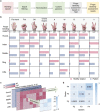Learning Hand Kinematics for Parkinson's Disease Assessment Using a Multimodal Sensor Glove
- PMID: 37150855
- PMCID: PMC10369271
- DOI: 10.1002/advs.202206982
Learning Hand Kinematics for Parkinson's Disease Assessment Using a Multimodal Sensor Glove
Abstract
Hand dysfunctions in Parkinson's disease include rigidity, muscle weakness, and tremor, which can severely affect the patient's daily life. Herein, a multimodal sensor glove is developed for quantifying the severity of Parkinson's disease symptoms in patients' hands while assessing the hands' multifunctionality. Toward signal processing, various algorithms are used to quantify and analyze each signal: Exponentially Weighted Average algorithm and Kalman filter are used to filter out noise, normalization to process bending signals, K-Means Cluster Analysis to classify muscle strength grades, and Back Propagation Neural Network to identify and classify tremor signals with an accuracy of 95.83%. Given the compelling features, the flexibility, muscle strength, and stability assessed by the glove and the clinical observations are proved to be highly consistent with Kappa values of 0.833, 0.867, and 0.937, respectively. The intraclass correlation coefficients obtained by reliability evaluation experiments for the three assessments are greater than 0.9, indicating that the system is reliable. The glove can be applied to assist in formulating targeted rehabilitation treatments and improve hand recovery efficiency.
Keywords: Parkinson's disease; finger flexibility; hand muscle strength; hand stability; smart glove; wearable bioelectronics.
© 2023 The Authors. Advanced Science published by Wiley-VCH GmbH.
Conflict of interest statement
The authors declare no conflict of interest.
Figures




Similar articles
-
A digital assessment system for evaluating kinetic tremor in essential tremor and Parkinson's disease.BMC Neurol. 2018 Mar 9;18(1):25. doi: 10.1186/s12883-018-1027-2. BMC Neurol. 2018. PMID: 29523097 Free PMC article.
-
Parkinson's disease hand tremor detection system for mobile application.J Med Eng Technol. 2016;40(3):127-34. doi: 10.3109/03091902.2016.1148792. Epub 2016 Mar 15. J Med Eng Technol. 2016. PMID: 26977823
-
Tremor's glove-an innovative electrical muscle stimulation therapy for intractable tremor in Parkinson's disease: A randomized sham-controlled trial.J Neurol Sci. 2017 Oct 15;381:331-340. doi: 10.1016/j.jns.2017.08.3246. Epub 2017 Aug 24. J Neurol Sci. 2017. PMID: 28991711 Clinical Trial.
-
[Clinicophysiological study of tremor in Parkinson's disease: quantitative tremor-based assessment of motor count using actigraphy].Nihon Rinsho. 1997 Jan;55(1):158-62. Nihon Rinsho. 1997. PMID: 9014442 Review. Japanese.
-
Epidemiology, diagnosis and differential diagnosis in Parkinson's disease tremor.Parkinsonism Relat Disord. 2012 Jan;18 Suppl 1:S90-2. doi: 10.1016/S1353-8020(11)70029-3. Parkinsonism Relat Disord. 2012. PMID: 22166466 Review.
Cited by
-
Leveraging Machine Learning for Personalized Wearable Biomedical Devices: A Review.J Pers Med. 2024 Feb 13;14(2):203. doi: 10.3390/jpm14020203. J Pers Med. 2024. PMID: 38392636 Free PMC article. Review.
-
Mechanically Tunable Composite Hydrogel for Multi-Gesture Motion Monitoring.Biosensors (Basel). 2025 Jun 27;15(7):412. doi: 10.3390/bios15070412. Biosensors (Basel). 2025. PMID: 40710062 Free PMC article.
-
Design and analysis of exoskeleton devices for rehabilitation of distal radius fracture.Front Neurorobot. 2024 Oct 18;18:1477232. doi: 10.3389/fnbot.2024.1477232. eCollection 2024. Front Neurorobot. 2024. PMID: 39493357 Free PMC article.
-
Upper limb intention tremor assessment: opportunities and challenges in wearable technology.J Neuroeng Rehabil. 2024 Jan 13;21(1):8. doi: 10.1186/s12984-023-01302-9. J Neuroeng Rehabil. 2024. PMID: 38218890 Free PMC article. Review.
-
Wearable rehabilitation wristband for distal radius fractures.Front Neurosci. 2023 Sep 14;17:1238176. doi: 10.3389/fnins.2023.1238176. eCollection 2023. Front Neurosci. 2023. PMID: 37781255 Free PMC article.
References
Publication types
MeSH terms
Grants and funding
- 20230401088YY/Science and Technology Development Plan Project of Jilin Province
- I2001E0059/National Research Foundation, Singapore and A*STAR under its RIE2020 Industry Alignment Fund - Industry Collaboration Projects (IAF-ICP) grant call
- 47744/Catalyzing Pediatric Innovation Grant
- Henry Samueli School of Engineering & Applied Science and the Department of Bioengineering at the University of California, Los Angeles
- Hellman Fellows Research Grant
LinkOut - more resources
Full Text Sources
Medical
